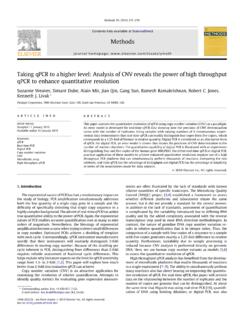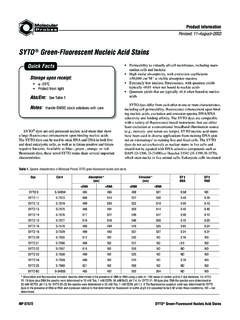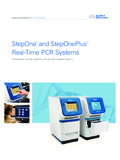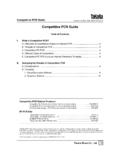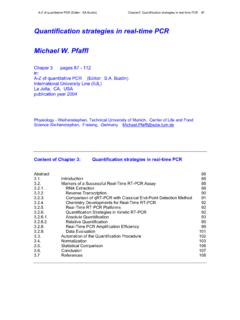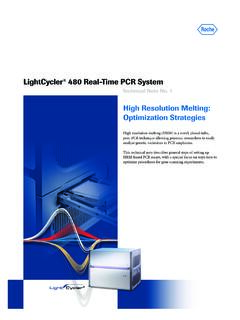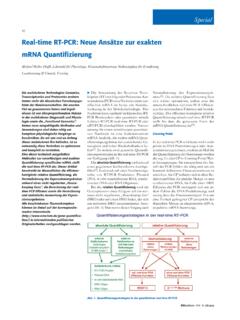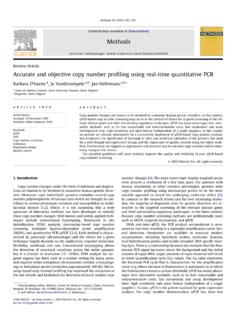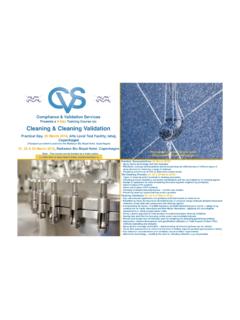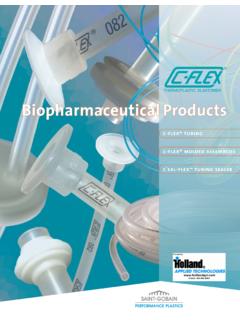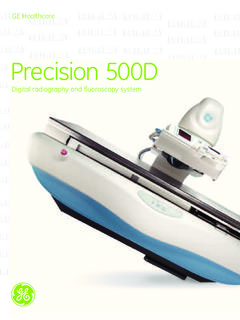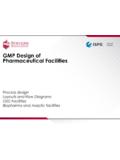Transcription of Application of qPCR method for transgene copy …
1 Application of qPCR method for transgene copy number determination in recombinant CHO cells in biopharmaceutical industry kulj Mihaela, Okr lar Veronika, Jamnikar Uro , Gaser Dominik, Matja Brinc, Francky AndrejBiopharmaceuticals, Cell and Molecular Biology Lek Pharmaceuticals 27, SI-1234 Menge IntroductionCultivated mammalian cells have become the dominant system for the production of recombinant proteins for clinical applications be-cause of their capacity for proper protein folding, assembly and post-translational modifications. CHO cells are most frequently used for protein production. Firstly cells are transfected with plasmid carry-ing a transgene and additionally a gene conferring a selective ad-vantage.
2 In the presence of the selection agent only those cells that express the selector gene survive. Following selection, survivors are cultivated as single clones. Clones are than evaluated and the cell line with the appropriate growth and productivity characteristics is chosen for the production of recombinant protein (1). It is very im-portant that the cell line is stable during the production phase. The transgene sequence, its copy number, number of integration sites, length of mRNA transcript and other parameters are evaluated on the genetic level. Since determination of transgene copy number and genetic stability are among the important parameters for re-combinant protein production, a fast and accurate method for its determination had to be developed.
3 In this work a qPCR method for transgene copy number determination using absolute quantification and TaqMan chemistry was developed. Materials and methodsCell culturesRecombinant CHO-K1 and CHO dhfr- cell lines of chinese hamster ovary (CHO) were used for recombinant protein production. CHO K1 cells were cotransfected with two plasmids one contain-zzing the sequences for the A and B subunit of the recombinant protein and the other containing a gene for antibiotic resistance. Plasmids were introduced into cells in ratio 10:1. After final clone selection a genetic stability test was performed. Cells were grown in 100ml spinner flasks for 120 generations and samples for copy number determination were collected every 20 generations (cul-ture was transfered to 500 ml spinner flasks to obtain enough cells for genetic analysis).
4 CHO dhfr- cells were used for testing of the influence of meth-zzotrexate on the transgene copy number. Cells were cotransfected with two plasmids, one containing a gene for DHFR and the other containing sequences for the A and B subunit of a recombinant protein. Cells were grown in T-flasks until confluency and pas-saged every two days. Cells were grown in 7 parallels and were treated with an increasing concentration of methotrexate, which was 0, 200, 400, 800, 1000, 1500, 2000 nM. During cell growth the concentration of MTX was slowly elevated to the final con-centration. Production was measured using an ELISA copy number determination a qPCR method using absolute quantification was developed. Specific amplicons on chromosome and plasmids were constructed.
5 The amplicon on chromosome was constructed on a single copy gene for glucagon (GLUC). On plas-mids the amplicons were constructed on specific transgenes for the A and B subunit of the recombinant protein and on a gene for anti-biotic resistance. For standard curve preparation, isolated genom-ic DNA from nontransfected cells and isolated plasmid DNA were used. Five serial dilutions were prepared in the range from aprox. 100-10000 copies per well (100pg/ l-10ng/ l) for genomic DNA and from 500-5 106 copies per well (1fg/ l-10pg/ l) for plasmid DNA. After analysis results were evaluated. Dilutions where CV of three replicates was > 0,3 were not used for standard curve preparation and copy number determination.
6 Genomic DNA from the sample was also prepared in five serial dilutions in the same range as for the standard curve of genomic DNA and relative standard curves were constructed for each sample and efficiency of amplification was calculated. Samples where efficiencies of amplification differed more than 10% compared to those of the standards were reana-lyzed. The copy number was determined as a ratio between the gluc and transgene copy number, separately for the A and B subunit of the recombinant protein and resistance gene. Results and discussionIn this study it was shown that the developed qPCR method gave promising results for transgene copy number determination for dif-ferent applications during the cell line development and production process.
7 The applied approach gave accurate and reproducible re-sults. It is also fast, robust and easy to perform. The costs were further reduced due to the use of 10 l reactions. It was tested and applied to three different applications: genetic stability study, evalu-ation of transfection efficiency and testing the influence of meth-otrexate on transgene copy number increase. Genetic stability studyGenetic stability of clones is an important parameter in longer culti-vation processes. Results of two different genetic stability tests are presented (Graph 1). A slight decrease in transgene copy number is observed, which was in the range of 15 - 20%. The difference can be assigned to the actual decrease in the copy number or to the of the method variability, which is in the range of 30%.
8 We conclude that the evaluated clone is stable since no significant deviation in copy number is 1: genetic stability tests of selected clone Influence of cotransfection ratio on transgenes integrationThe ratio between the two plasmids used for transfection and the ratio between the copy number of both subunits of the recombinant protein and the antibiotic resistance gene was compared (Graph 2). The ratio in copy number between the recombinant protein genes and the resistance gene after integration into the chromosome was approx. 5:1 (at a transfection ratio 10:1). An appropriate ratio of 1:1 is observed between the two subunits of the recombinant protein. Since the transgenes for the subunits are on the same plasmid we can assign the slight difference to the ideal 1:1 ratio to the method 2: integrated gene copy number after cotransfection with two plasmids.
9 A and B subunit genes of recombinant protein on the plas-mid and antibiotic resistance gene on another plasmid in a ratio 10:1. Influence of methotrexate on transgene copy number in-creaseCHO dhfr- cells were co-transfected with a plasmid containing the gene for DHFR and a separate plasmid containing the transgenes. Selection of cells occurred in the absence of hypoxantine and thy-midine, preventing growth of nontransformed cells. Expression of a recombinant protein can be augmented by exposing cells to meth-otrexate, a drug that blocks activity of DHFR. After 2-3 weeks of ex-posure to MTX the majority of cells die, but a small number of cells that overproduce DHFR survive. Upon MTX treatment, the trans-gene copy number in these cells increases (1, 2).
10 In our case CHO dhfr- cells were grown in seven parallels with different concentra-tions of methotrexate. The results show, that increasing the con-centration of methotrexate increased the transgene copy number per cell. In addition a larger copy number resulted in higher protein productivity (Graph 3). Graph 3: influence of methotrexate treatment on transgenes copy number and protein productionConclusions The results show that the developed qPCR method is suitable for transgene copy number determination during cell line development. The method provides accurate and reproducible results and is fast and easy to perform. It also has good prospects for partial automa-tization which is an important aspect in industrial production.
